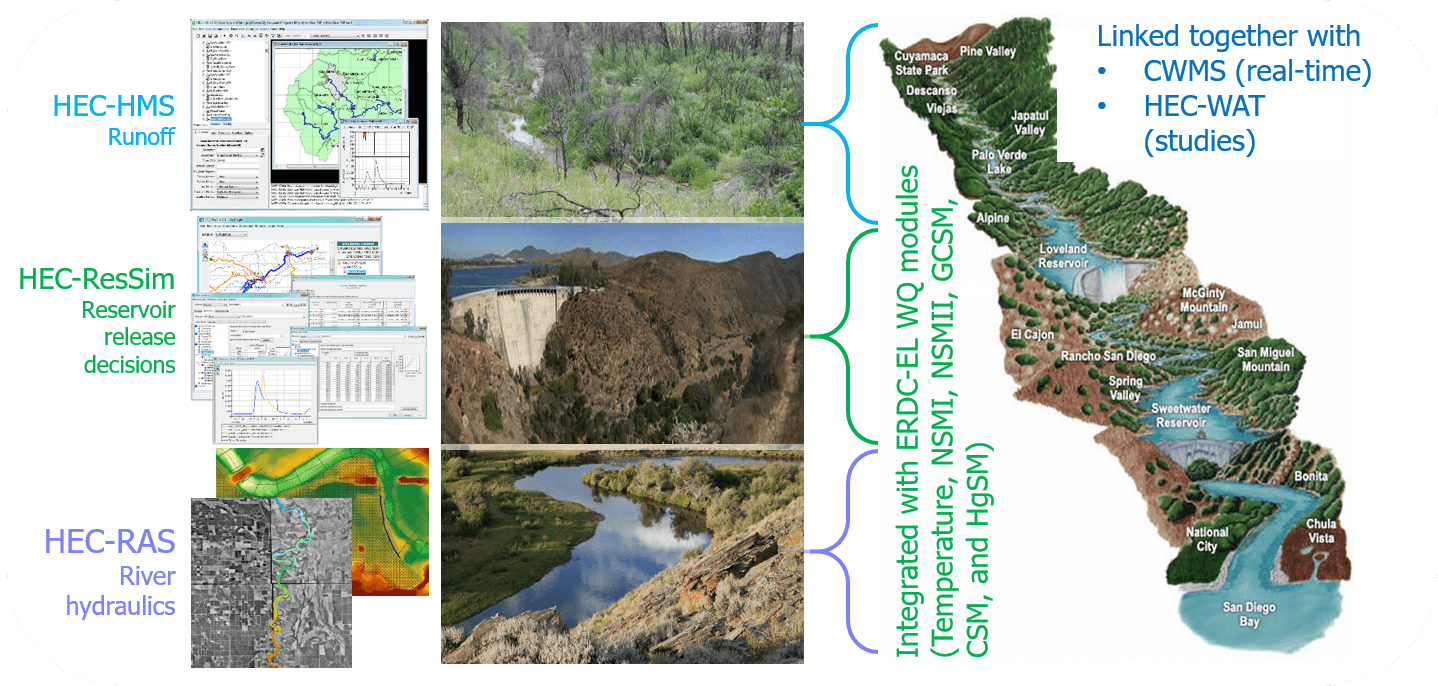Water Quality and Ecosystem Development
The U. S. Army Corps of Engineers (USACE) is building new water quality simulation and analysis capabilities within existing river, reservoir, and watershed runoff simulation programs (HEC-RAS, HEC-ResSim, and HEC-HMS), which are
widely used by USACE and other organizations. These capabilities will support the need for cost-effective science-based ecosystem restoration, management, and impacts assessment. Ecosystem Restoration is one of the primary missions
of USACE. The purpose of USACE ecosystem restoration activities is to restore significant ecosystem function, structure, and dynamic processes that have been degraded. Ecosystem restoration efforts involve an examination of the
problems contributing to the system degradation and the development of alternative means for their solution. The intent of restoration is to partially or fully reestablish the attributes of a natural, functioning, and self-regulating
system. Restoration opportunities associated with wetlands, riparian, and other floodplain and aquatic systems are likely to be most appropriate for USACE involvement. Authorities through which USACE can participate in the study,
design and implementation of ecosystem restoration projects include: 1) Section 206, Aquatic Ecosystem Restoration; 2)
Section 1135, Project Modifications for Improvement of the Environment; and 3)
Section 204, Beneficial Uses of Dredged Material; and 4) Studies specifically authorized by Congress, pursued under Investigations.
he Hydrologic Engineering Center (HEC) has a long history of developing software to solve flood control, navigation, and sediment problems faced by USACE. USACE districts have set up, calibrated, and applied many HEC models on rivers
and watersheds within their operational areas. The U.S. Army Engineer Research and Development Center’s Environmental Laboratory (ERDC-EL) has been developing nutrient, contaminant, and riparian vegetation modules that are able to be
fully integrated with a multitude of hydraulic and hydrologic models. The current collaboration between HEC and EL is intended to upgrade the HEC software to include water quality and ecosystem simulation capabilities to support ever
increasing USACE needs for evaluating ecosystem management conditions and project alternatives.
Purpose
ERDC-EL partnered with HEC to build new environmental quality modeling capabilities in HEC-RAS, HEC-ResSim, and HEC-HMS. HEC and ERDC-EL have developed a water quality engine and are developing user interface components that will
handle the water quality data (meteorology, bathymetry, water quality loadings), compute the hydrodynamics, and communicate with each HEC program and the ERDC-EL water quality modules. HEC-WAT plug-ins have been developed to support
automated simulation of the 2D hydrodynamic water quality model, CE-QUAL-W2, and the water quality capabilities of HEC-RAS. The plug-ins allow modelers to run multiple separate models in sequence and optionally link the outputs of one
model with the next model to create an integrated watershed water quality modeling system. When the new water quality capabilities in HEC-RAS, HEC-ResSim, and HEC-HMS have been completed, these can be leveraged within HEC-WAT.

Environmental Quality Modeling Capabilities
HEC-RAS simulates river hydraulics and sediment transport, computing river velocities, stages, profiles, and inundated areas. One-dimensional (1D) water quality capabilities have been developed and are being extended to simulate
water quality in river reaches. HEC-RAS is also being linked with the Riparian Vegetation Simulation Module (RVSM) to provide the ability to simulate the interactions of river hydraulics and riparian vegetation. The overall cost
to stake-holders interested in modeling water quality and interactions of flow, nutrients and vegetation for improved riverine ecosystem management and restoration is dramatically reduced due to leveraging these analyses against
existing modeling efforts.
HEC-ResSim simulates reservoir operations, computing releases and downstream hydrographs. Water quality capabilities are being developed to allow inclusion of environmental objectives in the reservoir operation decision-making
process, as well as supporting watershed-scale ecosystem assessment and management. The new software will provide the capability to simulate temperature, eutrophication (DO, nutrients, algae), and general constituents (conservative
and non-conservative) in reservoirs, where stratification is an important factor.
HEC-HMS simulates hydrologic processes, computing flow into rivers and reservoirs. Water quality capabilities are being developed to compute runoff temperature and generalized conservative and non-conservative constituent
concentrations. The quantity and quality of runoff computed by HEC-HMS for the upland watershed will provide vital inputs for HEC-RAS, HEC-ResSim, and other models.
The new water quality and riparian vegetation simulation and analysis capabilities developed in HEC-RAS, HEC-ResSim, and HEC-HMS will support the Corps’ needs for cost-effective science-based ecosystem restoration, management,
and impacts assessment. USACE is building or updating HEC models for 201 watersheds to support real-time simulation in the Corps Water Management System (CWMS). The water quality capabilities will leverage these models to build
integrated watershed-scale water quality simulation systems for real-time operations. These CWMS models can be rapidly converted to HEC-WAT models for application in watershed planning and impact analysis studies. The new
capabilities will streamline water quality model preparation and application, increasing efficiency and reducing costs while encouraging a watershed-scale approach to environmental restoration and management.
Future Development and Support
Current development efforts are being funded under the Ecosystem Management and Restoration Research Program (EMRRP). It is anticipated that future research and development of HEC water quality and ecosystem capabilities will be
funded under EMRRP, other R&D programs, and reimbursable studies. It is recognized that as HEC software continues to evolve that upgrades and maintenance of water quality and ecosystem capabilities will need to be addressed.
ERDC POC:
Dr. Todd Steissberg
530-304-3510
clearwater@usace.army.mil
HEC POC:
Ms. Lea Adams
530-756-1104
clearwater@usace.army.mil
Last Updated: 02/13/2020